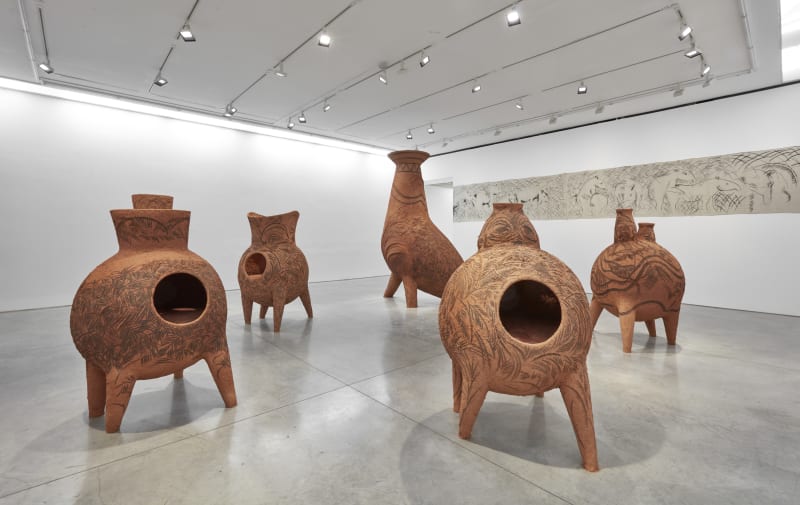BY WILLIAM CORWIN
How we depict our gods exposes our deepest aspirations and expectations of the universe and nature. Gabriel Chaile’s gods are big, but not so big that we can’t relate to them and stand in the room with them. They are terrifying and sweet simultaneously—a great deal of Chaile’s success comes from the fact that his aesthetic resembles the cuteness/terror of a Studio Ghibli typology. Ghibli plays with the forest demons of Shinto, also gods of nature, whilst Chaile’s monsters are monumental adobe undertakings. In the current exhibition are five beings, all fabricated in the gallery. The largest, Candelaria (2025), holds the attention of the room, astride its two legs and pigeon-like mein, and will be familiar to New York Chaile enthusiasts as it has the same form as his previous pieces on the Highline The wind blows where it wishes (2023) and in the New Museum Triennial Mamá Luchona (2021). The other four—Alamito, Santa Maria, Aguada, and Condorhuasi (all 2025)—are quadrupedal beasts, which, as installed in the gallery, seem to trail Candelaria in a plodding semicircular march. Their four-leggedness is key to their accessibility: each of the legs is not identically positioned or static, and instead are placed at different angles, giving the creature a sweet sort of fussiness, as if it can’t quite stabilize its roly-poly body, or perhaps that it can’t even decide whether to follow the oversize leader, Candelaria, or not. Each also has an alternative utilitarian purpose as a bread oven (according to the press release) and so the spherical bodies are perforated by a circular maw (or anus) and a turret-like chimney(s) at the top.
The beasts seem to yowl or holler into the gallery space, or at each other as they move round and round the room. Candelaria holds its mouth straight up to the sky—a vase rather than an oven. Chaile’s decision to hold fast to the utilitarian in his adobe vessels keeps the forms consistent and simple, and allows him to focus on playing with subtler gestures such as the witty positioning of legs/supports. He draws the simplest of designs into the exterior of his sculptures. His bread ovens in particular bear a striking similarity to the blue faience guardian hippopotami found in Ancient Egyptian tombs, which are decorated with lotuses from the Nile. Chaile’s beasts are inscribed with palm fronds and undulating lines which might be hills, might be streams, giving the works a rich tactility. Like the Egyptian ceramic pieces, the natural decoration positions the objects neatly within an imagined natural ecosystem from which the energy of the being is drawn. We have sculpture here that absorbs indigenous narratives but also engages with the utilitarian: furniture as sculpture; an invocation as ancient as the practical magic of Shang Dynasty ritual bronze tea tables or as modernist as Ray and Charles Eames.
All of the adobe figures have two sets of eyes, meaning that whether they face us or not, they are always keeping watch, which hints at a gently present paranoia. That the pot-bellied characters also seem to hesitantly follow a larger more intimidating figure, and that offers a political interpretation, which luckily doesn’t hit you over the head. The most intimidating of the adobe sculptures is Candelaria, who has a large pair of eyes and a toothy mouth on its breast as well as a smaller pair of eyes on its neck. On the upper quadrant of three of the walls of the gallery, Chaile has hung a charcoal-and-crayon-on-canvas frieze depicting tapirs cavorting in a natural setting (six contiguous pieces, all untitled, 2025). The tapir is an odd-looking beast, with a long awkward snout and round furry body. In Chaile’s depiction they nuzzle each other, munch on grass, and hump amiably, drawn in the same long and open strokes as the decoration on the bodies of the sculpture. Like the other beasts in the artist’s menagerie, tapirs are not overtly cute like the media-darling capybara, or genuinely terrifying like the dread jaguar; they are equivocal and funny looking—maybe sweet, maybe indifferent—and also perfect gods for our moment in time.


